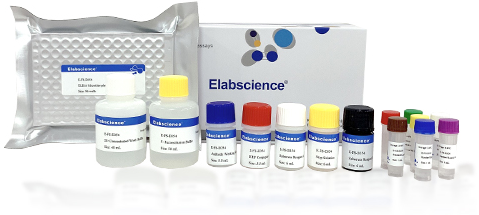Food Safety Kits and Reagents
Elabscience® is a global supplier of food and feed safety solutions, offering an array of innovative testing solutions for the qualitative and quantitative detection of mycotoxins, hormones, antibiotics, vitamins, microorganisms, allergens, and other analytes in food, feed, and biological fluids.
Elabscience® food safety kits feature over 5 sample pretreatment solutions and undergo a rigorous verification process. Each product can verify more than 5 natural samples with a coefficient of variation of less than 5%. These kits encompass various types in one package, maintaining consistent storage temperature, long shelf life, easy operation, quick detection time, and stable product performance. They are extensively employed in large-scale industrial testing and precise scientific research experiments.

Analytes Categories
Residues & Contaminants
Detection of hormones, anabolics, antibiotics and other drug residues in different matrices.
Mycotoxins
Elabscience® mycotoxins test kits allow rapid qualitative and quantitative analysis of mycotoxins.
Vitamins
To measure the exact concentration of vitamins in matrices.
Microbiology
Different categories of microbiological contamination. organisms, Pathogenic bacteria, Viruses, Bacterial toxins.
Food Allergens
Food allergies occur when the body's immune system reacts to certain proteins in food.
Product Applications
Provide detection of fish and shrimp, chicken, cattle and sheep and other animal muscle and liver kit solutions, such as chloramphenicol, neomycin, penicillin, bacitracin, etc.
Provide detection of substances extracted from beans, cereals, feed, nuts, medicinal materials and their derivatives kit. Such as aflatoxin B1, deoxynivalenol, ochratoxin A, β-agonist, etc.
Provide testing solutions for substances extracted from honey, eggs and their processed products. Such as nitrofurazone, doxycycline, metronidazole, ciprofloxacin, etc.
Provide solutions for detecting substances extracted from serum, urine, and cell-related fluids. Such as T-2 toxin, clenbuterol, metronidazole, ciprofloxacin, etc.
Provides solutions for detecting substances extracted from oils, beverages, chilli powder, and juices. Such as fumonisin, biotin, sudan I, salmonella, etc.
Product Features
Universal
Multiple Analytical
| Analytes/Methods | LFDS |
ELISA |
PCR |
Microbiological |
|---|---|---|---|---|
| Residues & Contaminants | ||||
| Mycotoxins | ||||
| Vitamins | ||||
| Microbiology | ||||
| Food Allergens | ||||
| Characteristics | Rapid | Efficient | Highly Specific | High Accuracy |
| Incubation Time | 5-10 min | 15-75 min | 27.5 min | 44 h |
| Result Type | Qualitative | Qualitative/Quantitative | Qualitative/Quantitative | Quantitative |
| Storge | 25℃ | 4℃ | - 20℃ | 4℃ |






